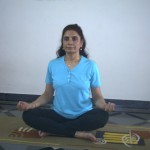 By Dr. Rita Khanna
By Dr. Rita Khanna
How is pranayama for stress effective? In Yoga, breathing is considered a very important process as it is the most vital means of absorbing Prana into the body. The Shastras explain how Prana gives consciousness and life to every creature which breathes.
Pranayama in Scriptures
According to Taittiriya, Brahmana and Maitri Upanishads, and Shiva Swarodaya, the breath is referred to as the vehicle of Brahman or cosmic consciousness. Even the Bible implies that man was given consciousness and life through the breath: “The Lord God formed man out of the dust of the ground and breathing into his nostrils the breath of life, he became a living soul” (Ge. 2:17). The breath itself, being imparted from the cosmic self, contains the cosmic force therein.
The breath is so vital in human existence that the ancient Rishis or seers evolved a complete science around it just from studying the simple process of respiration. However, this science, Swara Yoga, should not be confused with Pranayama, though both deal with Prana. Swara Yoga emphasizes the analysis of the breath and the significance of different Pranic rhythms, whereas, Pranayama involves techniques to redirect, store and control Prana.
Prana and mind exert an influence on each other. Pranayama for stress is a viable solution. When the Pranas are restless, they affect the mind and vice versa. By controlling the Pranas through the practice of Pranayama, the restlessness of the mind is automatically controlled.
Balancing Ida and Pingala:
Becoming aware of the breath has a calming effect on the mind. In Pranayama, relaxation is achieved through total awareness of the breath and through the subtle control and modification of the breath. As per Swara Yoga, three different energy flows are created in the nostrils – Ida, Pingala and Sushumna.
The left nostril is connected to the Ida network of Nadis, and the right nostril to the Pingala network of Nadis. When the left nostril is flowing, Ida stimulates the mental faculties; and when the right nostril is flowing, Pingala stimulates the body.
When both the nostrils become active simultaneously, then Sushumna Nadi stimulates the Atma or spiritual potential. This usually occurs for a couple of minutes only, during the period of change over of breath from one nostril to the other.
Correct Breathing:
Most of us breathe incorrectly, using only a tiny part of our lung capacity – Shallow respiration or rapid breathing, as in a stressful situation, builds up stagnant air in the lower regions of the lungs. Also, normal breathing occurs either in the abdomen, thorax, or chest. Combining the abdominal and thoracic breathing makes it possible to inhale the optimum amount of air into the lungs and exhale the maximum amount of waste air. According to Yoga, this is the way everyone should be breathing.
 Anulom Vilom Pranayama:
Anulom Vilom Pranayama:
This form of Pranayama induces calmness and tranquillity in several ways. It clears all the Pranic passages of any blockages due to the presence of toxins-It equalizes the flow of Prana in the Ida and Pingala network of Nadis.
It purifies the blood systems of all toxins. The purifying action of Anulom Vilom Pranayama on the brain cells enhance the efficiency of the brain centers, allowing them to function at their optimum capacity. In the same way, as the Shatkarma practices cleanse the physical body of toxins, Anulom Vilom Pranayama does a more subtle job of cleansing the Nadis or energy pathways, removing obstacles to the clean working of the sympathetic and parasympathetic nervous systems.
By equalizing the flow of Prana in the Ida and Pingala Nadis, Anulom Vilom Pranayama rectifies imbalances due to the ‘habitual’ predominance of the sympathetic nervous system, which results from chronic, ongoing stress. The balancing of the flow of Prana has a positive influence on the body’s stress response activity and helps to keep levels of stress and tension within the normal range.
Technique:
Use the thumb of your right hand to close your right nostril and inhale with your left nostril. Then close your left nostril with your right hand’s index and middle fingers and exhale from the right nostril. Now, in the reverse manner, inhale with the right nostril, close your right nostril with your right hand’s thumb, then exhale with the left. This forms one round of Anulom Vilom Pranayam.
 Ujjayi Pranayama:
Ujjayi Pranayama:
Ujjayi pranayama acts on the carotid sinuses, which are situated in the region of the throat and are beside the main blood artery that supplies the brain. The carotid sinuses detect blood pressure. When blood pressure rises, these carotid bodies send a message to the brain, and the brain in turn sends a message to the heart to slow down, thereby bringing the blood pressure down to a reasonable level. If the blood pressure is too low, the same process is repeated, and the heart speeds up to increase the blood pressure.
While practicing Ujjayi Pranayama, a slight pressure is exerted on the carotid sinuses. In a stressful condition, the blood pressure rises as the heart beats faster. The pressure on the carotid bodies brought about in Ujjayi Pranayama helps to slow down. Either as a stress aid in a temporary stressful situation or as a long-term therapy, Ujjayi is an invaluable pranayama for stress. Ujjayi Pranayama is a standard adjunct in Yoga therapy for blood pressure, heart problems, anxiety, stress,, and all conditions in which relaxation is of prime need to bring tranquility to the body and mind complex. Abdominal breathing and breath awareness are also used as adjuncts to relaxation therapy.
Technique:
Inhale slowly and deeply through the nose while exhaling, contract the air passage and exhale slowly with a whispering sound.
Brahmari, Kapalbhati and Bhastrika Pranayama:
The other techniques of Pranayama recommended in managing stress are Brahmari, Kapalbhati and Bhastrika. Brahmari is useful for removing mental and emotional tension, anxiety and hysteria. Bhastrika and Kapalbhati are essential for revitalizing the exhausted and depressed nervous systems. Bhastrika revitalizes the sympathetic nervous system, while Kapalbhati tones up the parasympathetic nervous system.
Techniques:
Brahmari Pranayama: Inhale slowly and deeply through the nose. Keep the lips closed and start humming loudly and smoothly like a black bee through the throat. One has to make a sound from the throat via the nose.
Kapalbhati Pranayama: Exhale forcefully through your nose. Start with 25 strokes and do it slowly. This is one round of Kapalbhati.
Bhastrika Pranayama: Do 25 strokes of Kapalbhati and proceed to one round of Anulom Vilom without any break. This is one round of Bhastrika.
Aum Shanti
If you feel inspired by this article, feel free to publish it in your Newsletter or on your Website. Our humble request is to please include the Resource as follows:
Courtesy: Dr. Rita Khanna’s Yogashaastra Studio.
A popular studio that helps you find natural solutions for complete health.
Also conducts online Yoga Courses & Naturopathy Guidance.
Mobile: + 919849772485
Ph:-91-40-65173344
Email: yogashaastra@gmail.com
About Dr. Rita Khanna
Dr. Rita Khanna is a well-known name in Yoga and Naturopathy. She was initiated into this discipline over 25 years ago by the world-famous Swami Adyatmananda of Sivananda Ashram in Rishikesh (India).
Dr. Rita firmly believes that Yoga is a scientific process that helps us to lead a healthy and disease-free life. She is also actively involved in practicing alternative medicines like Naturopathy. Over the years she has successfully practiced these therapies over the years and assisted several chronic and terminally ill patients through Yoga, Diet, and Naturopathy. She is also imparting Yoga Teachers Training.
Dr. Rita Khanna runs a Yoga Studio in Secunderabad (Hyderabad, India).
To see our selection of Yoga teacher training courses, please visit the following link.
https://aurawellnesscenter.com/store/
Click here to see our online Yoga Nidra teacher training course.
Are you an experienced teacher looking for YACEP credits or continuing education?
Subscribe to Our Newsletter for Special Discounts and New Products
Related Resources
52 Essential Principles of Yoga Philosophy to Deepen your Practice
by Rina Jakubowicz
A Relaxing Way to De-stress, Re-energize, and Find Balance
by: Gail Boorstein Grossman.
YOGA: THE PATH TO HOLISTIC HEALTH
by B.K.S. Iyengar
TEACHING YOGA: Essential Foundations and Techniques
By Mark Stephens
Related Research
Effect of Modified Slow Breathing Exercise on Perceived Stress and Basal Cardiovascular Parameters.
Naik GS, Gaur GS, Pal GK
Int J Yoga, 11(1):53-58, 31 Dec 2017
Effects of Various Prāṇāyāma on Cardiovascular and Autonomic Variables.
Nivethitha L, Mooventhan A, Manjunath NK
Anc Sci Life, 36(2):72-77, 30 Sep 2016
Yoga and heart rate variability: A comprehensive review of the literature.
Tyagi A, Cohen M
Int J Yoga, 9(2):97-113, 30 Jun 2016
About Pranayama for Stress and Anxiety
By Faye Martins and Jenny Park
Are you feeling overwhelmed, anxious, and stressed out? You’re not alone. Stress is a common issue that affects millions of people around the world. While there are many ways to manage stress, one effective method that has been practiced for centuries is Pranayama. This ancient yogic breathing technique can help reduce stress and anxiety while promoting relaxation and well-being. In this blog post, we will explore what Pranayama is, the different types of Pranayama for stress relief, its benefits, how to do it properly, and some helpful tips to get you started on your journey towards a calmer mind and body. So let’s dive into the world of Pranayama!
What is Pranayama?
Pranayama is a Sanskrit term for “extension of the life force.” It is an ancient Indian practice that involves controlling one’s breath to achieve balance and harmony within the body. The method of Pranayama aims to regulate the prana, which refers to vital energy or life force.
In yogic philosophy, it is believed that practicing Pranayama can bring more oxygen into our bodies while removing toxins and negative emotions. This can help us feel more relaxed, focused, and energized, ultimately leading us toward spiritual growth.
There are many different types of Pranayama techniques used in yoga practices. Some focus on slow breathing patterns, while others involve rapid breathing exercises or alternate nostril breathing. Each method has its unique benefits for the mind and body.
While it may seem like simple breathing exercises, Pranayama requires patience and dedication to master correctly. Regular practice can be a powerful tool for reducing stress levels and improving overall well-being.
The Different Types of Pranayama for Stress
Pranayama is a practice of controlling breath that originated in ancient India. It involves a series of breathing exercises designed to calm the mind, relax the body, and reduce stress levels. Several different types of pranayama techniques can be used for stress relief.
One type of pranayama technique is called Nadi Shodhana, also known as alternate nostril breathing. This technique involves inhaling through one nostril while blocking off the other nostril with your thumb, then exhaling through the other nostril while blocking off the first one with your finger.
Another pranayama technique is Bhramari Pranayama or Bumble Bee Breath, which uses deep inhalation followed by exhalation and a humming sound made from the mouth closed, but the throat opened.
Kapalabhati Pranayam follows quick and forceful exhalations after each short inhalation, where you must focus on exhaling more than inhaling.
Sheetali and Sheetkari Pranyams both involve cooling forms of breathing where sheetali requires curling up the tongue lengthwise into a tube shape, whereas sheetkari requires biting onto your lower lip tightly before taking long breaths inwards via mouth opening between lips keeping teeth together.
Practicing these different pranayama techniques can help relieve stress and anxiety by calming down our nervous system quickly and efficiently.
The Benefits of Pranayama for Stress
Pranayama, the ancient practice of controlling breath, has been proven to have several benefits for stress. One significant advantage is that it helps calm the mind and reduce anxiety. By focusing on breathing techniques and slowing down your breathing rate, you activate the parasympathetic nervous system responsible for relaxation.
Another critical benefit of pranayama for stress is that it can lower blood pressure and heart rate. This happens due to deep breathing, which allows more oxygen to enter the body while carbon dioxide exits. When this happens, the heart rate slows, and blood pressure decreases.
Moreover, pranayama has been found to improve overall mental health by reducing symptoms of depression and promoting emotional stability. It can also enhance cognitive performance by improving focus, concentration, and memory retention.
In addition to these benefits, practicing pranayama regularly can boost immunity levels by increasing circulation and stimulating lymphatic flow. With a more robust immune system comes better physical health, eventually reducing stress levels.
Incorporating pranayama into your daily routine can work wonders in managing stress levels while promoting holistic wellness for mind and body.
How to Practice Pranayama for Stress
Pranayama is a powerful tool to help reduce stress and anxiety. It involves controlling your breath using different techniques that can calm the mind, decrease tension in the body and promote relaxation. Here are some simple steps you can follow to practice pranayama for stress:
1. Find a quiet place where you won’t be disturbed: It’s essential to create an environment free of distractions so you can focus on your breathing.
2. Sit comfortably: You can sit cross-legged on the floor or in a chair with your feet flat. Make sure your spine is straight but relaxed.
3. Take deep breaths: Start by taking slow, deep breaths through your nose and exhaling slowly through your mouth.
4. Try different techniques: Several pranayama techniques can help alleviate stress, such as Nadi Shodhana (alternate nostril breathing) or Ujjayi (ocean-sounding breath). Experiment with these different methods until you find the best one for you.
5. Practice regularly: The benefits of pranayama increase with regular practice, so try incorporating it into your daily routine.
Remember that everyone’s experience with pranayama will be unique, so don’t get discouraged if it takes time to feel its effects. With patience and persistence, this ancient practice can become an effective tool for managing stress in our modern world.
Pranayama for Stress Tips
Pranayama is a powerful tool for relieving stress and anxiety. Here are some tips to help you make the most of your Pranayama practice:
1. Find a quiet, comfortable space where you won’t be disturbed.
2. Start with simple breathing exercises before moving on to more advanced techniques.
3. Be patient and kind to yourself. Don’t push too hard or expect immediate results.
4. Practice regularly – even just 5-10 minutes a day can greatly impact your mental health.
5. Stay hydrated by drinking plenty of water throughout the day.
6. Avoid practicing Pranayama right after eating as this can interfere with digestion and cause discomfort.
7. Incorporate other healthy habits into your routine such as regular exercise, healthy eating, and getting enough sleep.
By following these tips, you’ll be well on your way to experiencing the many benefits that Pranayama offers when it comes to managing stress and anxiety.
Conclusion
Pranayama is a powerful technique for managing stress and anxiety. It involves controlled breathing exercises that help calm the mind, reduce tension in the body, and promote relaxation. By incorporating Pranayama into your daily routine, you can notice significant improvements in your overall well-being.
There are many different types of Pranayama that you can try, including Bhastrika, Kapalbhati, Anulom Vilom, Sheetali, and more. Each method has unique benefits and can be practiced by people of all ages and fitness levels.
The key to success with Pranayama is consistency. Start by practicing for a few minutes each day and gradually increase the time as you become more comfortable with the exercises. Remember to breathe deeply from your diaphragm while maintaining a relaxed posture throughout the practice.
Whether you’re dealing with chronic stress or simply looking for ways to improve your overall health and well-being, Pranayama is an excellent tool for achieving balance in both body and mind. So take some time out each day to focus on your breath and enjoy the calming effects of this ancient practice.
© Copyright – Aura Wellness Center – Publications Division

 Anulom Vilom Pranayama:
Anulom Vilom Pranayama: Ujjayi Pranayama:
Ujjayi Pranayama:
By reading this article, my sushmna start awakening. This is a very powerful article!
In Pranayama, relaxation is achieved through the total awareness of the breath, and through the subtle control and modification of the breath. Nice sharing!
The balancing of the flow of Prana has a positive influence on the body’s stress response activity, and helps to keep levels of stress and tension within the normal range.